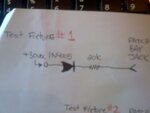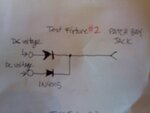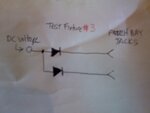P
ParkerMike
Guest
I was looking at schematics of test fixtures and i have notices there is a diode placed in series for each internal wire. These series diode for each wire is it protect the wiring from getting to hot when there is a short or over voltage.
The test fixtures have a patch bay jacks or break out box connections. The series diode protects the wiring and components inside the test fixture in care of patching the wrong jacks together in different configurations. Also the diode protects the test fixtures wiring when there is a short circuit or shorted component on the circuit board under test
How do these series diodes work? when there is a short or when an older voltage is applied to them?
The wiring must be DC voltage if you have a Diode placed in series, but when you put a higher or lower DC voltage on both sides of a Diode in series it will open or short?
When connecting the patch bay jacks in wrong configurations the diode has DC voltage on both sides of it
or a shorting the DC voltage depending of the wiring of the patch bay jacks you patched in a wrong configuration
What are these types of diodes called for these types of protection?
The test fixtures have a patch bay jacks or break out box connections. The series diode protects the wiring and components inside the test fixture in care of patching the wrong jacks together in different configurations. Also the diode protects the test fixtures wiring when there is a short circuit or shorted component on the circuit board under test
How do these series diodes work? when there is a short or when an older voltage is applied to them?
The wiring must be DC voltage if you have a Diode placed in series, but when you put a higher or lower DC voltage on both sides of a Diode in series it will open or short?
When connecting the patch bay jacks in wrong configurations the diode has DC voltage on both sides of it
or a shorting the DC voltage depending of the wiring of the patch bay jacks you patched in a wrong configuration
What are these types of diodes called for these types of protection?


